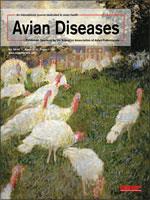Avian astrovirus infections are widespread in many countries, and infections have been connected with enteritis and increased mortality in young birds. In the present study, fecal samples were collected during 2009–2012 from a total of 156 meat turkey flocks. Astrovirus presence and type differentiation was performed with the use of two molecular diagnostic approaches. Out of 156 flocks, 48.7% were found to be TAstV positive. Depending on the method used for type differentiation, TAstV-2 and TAstV-1 prevalence was between 31.4%–41% and 9.6%–15.4%, respectively. No avian nephritis virus was detected. About 30% of astrovirus-positive flocks were infected with both types of TAstV. Phylogenetic analysis based on the partial polymerase gene sequence revealed the genetic variability of isolated TAstV, and most of the detected TAstV-2 belonged to the European lineage of astroviruses. Statistical analysis suggested the positive but weak correlation between the presence of astrovirus and health status (slightly more frequent detection of TAstV in sick, diarrheic birds) and also negative medium correlation between age and astrovirus occurrence.
Nota de Investigación—Astrovirus en granjas de pavos comerciales en Polonia en los años 2009–2012.
Las infecciones por astrovirus aviar son comunes en muchos países y estas infecciones se han relacionado con enteritis y aumento de la mortalidad en aves jóvenes. En el presente estudio, se recolectaron muestras de heces durante los años 2009 al 2012, de un total de 156 parvadas de pavos de carne. La presencia de astrovirus y su tipificación se realizó con el uso de dos métodos de diagnóstico molecular. De las 156 parvadas, el 48.7% resultaron ser positivas al astrovirus de los pavos. Dependiendo del método utilizado para la tipificación, la prevalencia de astrovirus de los pavos tipo 2 y tipo 1 fue de entre 31.4% a 41% y de 9.6% a 15.4%, respectivamente. No se detectó al virus de la nefritis aviar. Alrededor del 30% de las parvadas positivas para la presencia de astrovirus estaban infectadas con ambos tipos. El análisis filogenético basado en la secuencia parcial del gene de la polimerasa reveló la variabilidad genética de los aislamientos de astrovirus de los pavos y la mayoría de los aislamientos del serotipo 2 pertenecían al linaje europeo de astrovirus. El análisis estadístico sugirió una correlación positiva pero débil entre la presencia de astrovirus y el estado de salud (con detección de astrovirus de los pavos ligeramente más frecuente en aves enfermas y diarreicas) y también se observó una correlación negativa intermedia entre la edad y la presencia de astrovirus.





